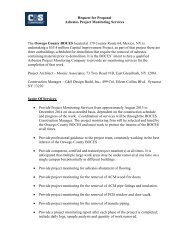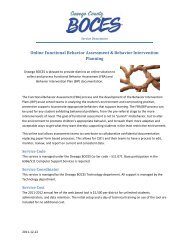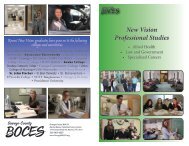Functional Behavior Assessment and Behavior Intervention Plans ...
Functional Behavior Assessment and Behavior Intervention Plans ...
Functional Behavior Assessment and Behavior Intervention Plans ...
You also want an ePaper? Increase the reach of your titles
YUMPU automatically turns print PDFs into web optimized ePapers that Google loves.
examples of well-defined behavior include defining verbal off-task behavior as: "Charles makes<br />
irrelevant <strong>and</strong> inappropriate comments during reading class (e.g., "This is dumb." or "Anyone<br />
could do that."); <strong>and</strong> hyperactivity as: "Jan leaves her assigned area without permission (e.g.,<br />
walks around class, goes to reward area of class), completes only small portions of her<br />
independent work (e.g., 3 of 10 problems), <strong>and</strong> blurts out answers without raising her h<strong>and</strong>.<br />
III. BACKGROUND INFORMATION RELEVANT TO THE TARGET BEHAVIOR<br />
Review of Pertinent Records<br />
A review of a student's records involves analysis of the history related to the target behavior.<br />
Information from the student's files may provide details that help examiners underst<strong>and</strong> why the<br />
child is having difficulties in school. May include; Attendance records, Grade reports, Discipline<br />
<strong>and</strong> behavior records. Sample record reviews are included in<br />
ATTACHMENTS A<br />
Previous <strong>Intervention</strong>s <strong>and</strong> Outcomes<br />
Pre referral documentation may include when staff started to intervene, what interventions were<br />
tried, for how long, with what results <strong>and</strong> how they're documented, etc. Anecdotal records of<br />
changes made, differentiation provided, interventions tried – along with their results – should be<br />
maintained. When a teacher <strong>and</strong> other school staff have been providing <strong>and</strong> documenting<br />
interventions <strong>and</strong> progress monitoring for a student for some time, the process itself calls for a<br />
continuous gathering, analyzing <strong>and</strong> summarizing of data. Samples-<br />
ATTACHMENTS B<br />
Summary of Interviews (parent, staff, student)<br />
Interviewing with the student <strong>and</strong>/or parent along with targeted staff members is recommended.<br />
Sample interviews ate included in<br />
ATTACHMENTS C<br />
Other relevant information (including cognitive, affective <strong>and</strong> environmental conditions)<br />
This information may be based upon previous psychological information, social history, health<br />
information or involved agency information<br />
IV. OBSERVATION OF TARGETED BEHAVIOR<br />
In collecting information to refine the definition about behavior, it is necessary to observe the<br />
student in various settings (e.g., classroom, cafeteria, playground, <strong>and</strong> other social settings),<br />
during different types of activities (e.g., individual, large group, or cooperative learning), <strong>and</strong> to<br />
discuss the student’s behavior with other school personnel or family members. This will help the<br />
team to determine the exact nature of the behavior <strong>and</strong> to narrow its scope of the examination of<br />
the problem situation.<br />
Date Location Observer Notes<br />
Some sample observation forms are included in ATTACHMENT D







